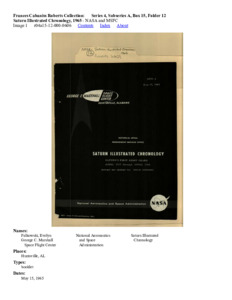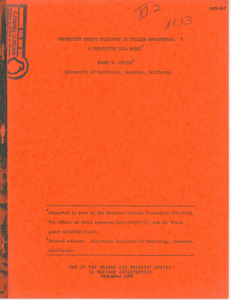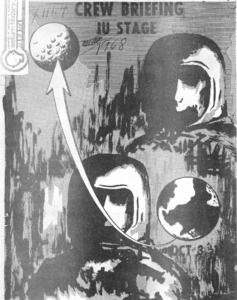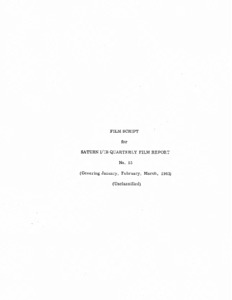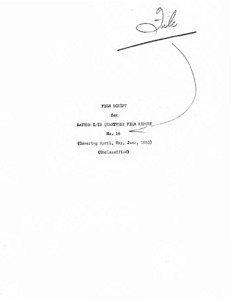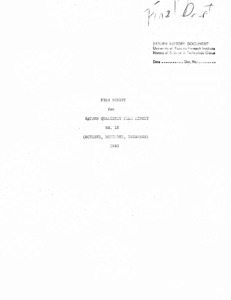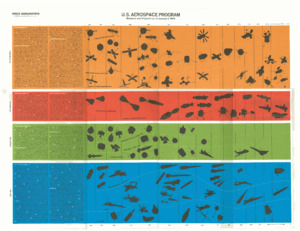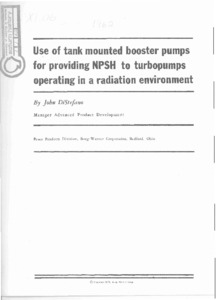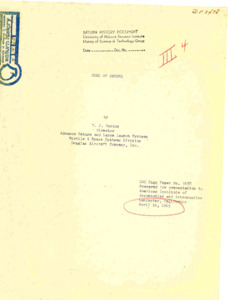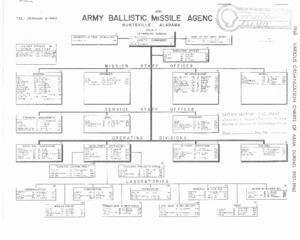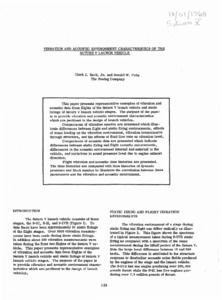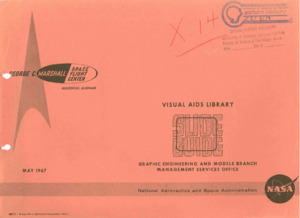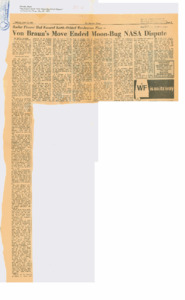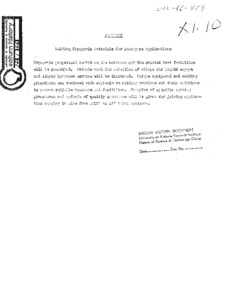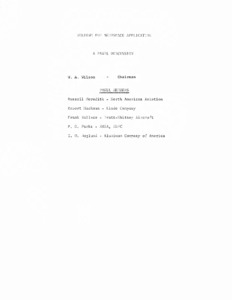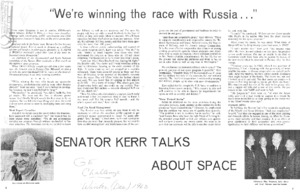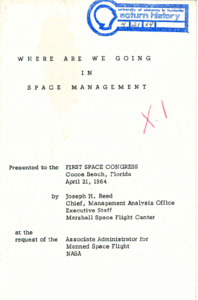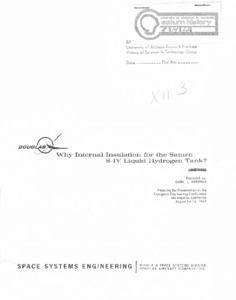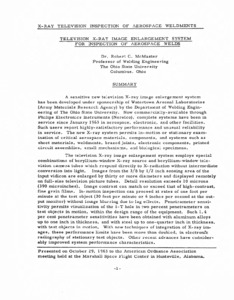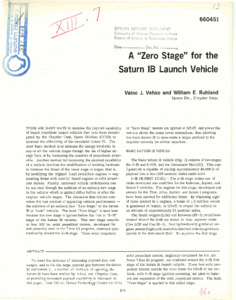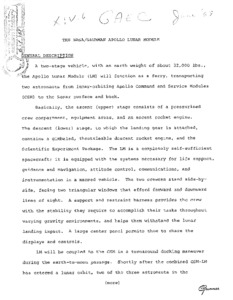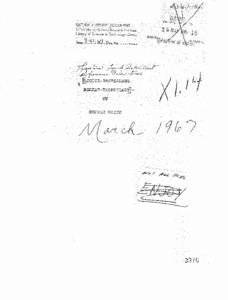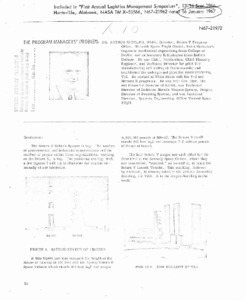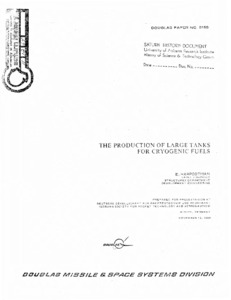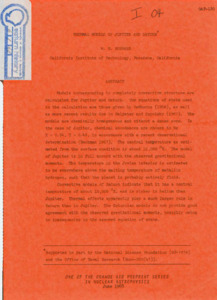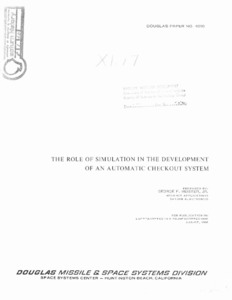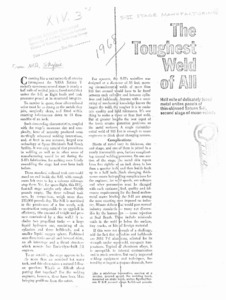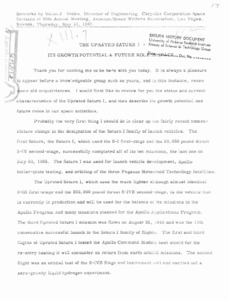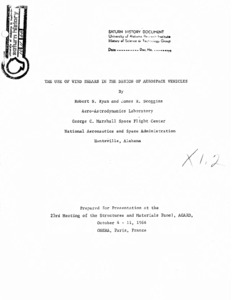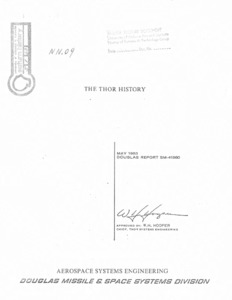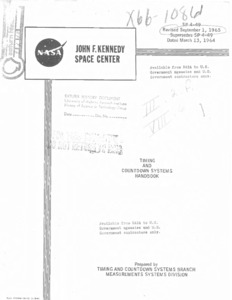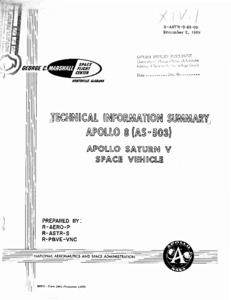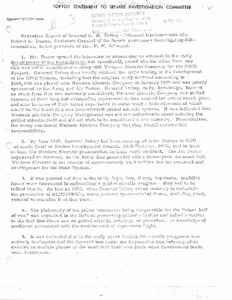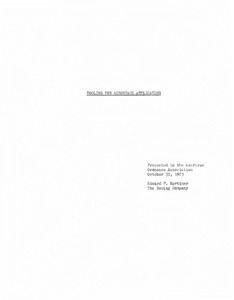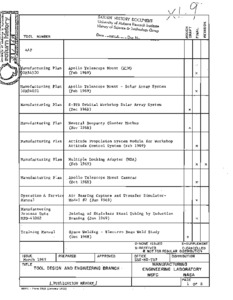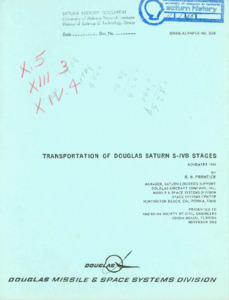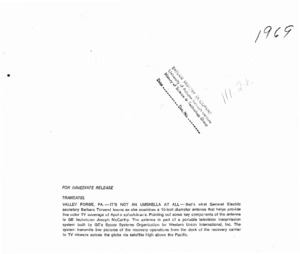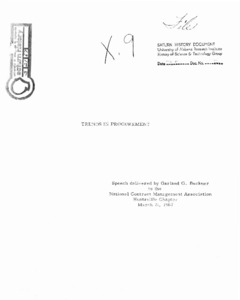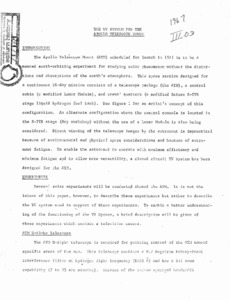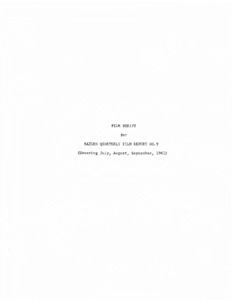
Browse Items (716 total)
Sort by:
-
Saturn Illustrated Chronology, 1965
NASA and MSFC -
Convective Energy Transport in Stellar Atmospheres: A Convective Cell Model.
One of the Orange Aid Preprint Series in Nuclear Astrophysics, September 1968.; Supported in part by the National Science Foundation [GP-7976], the Office of Naval Research [Nonr-220(47)]. ; ABSTRACT: The motion in a convectively unstable region is expanded into an ensemble of convective cells. Each of these cells interacts with the surrounding medium according to the semiempirical model proposed by Turner (1963 ). Possible detailed models of the flow patterns within each cell are presented. The radius and velocity of these cells are given as functions of distance moved. The convective flux and rms velocity are given as averages over the ensemble of cells. As in the standard mixing length theory the principle uncertainty remains the average initial radius of the cells. -
"Crew Briefing : Instrument Unit Stage Presentation".
Document outlining different slides of a presentation containing numerous organizational charts, diagrams and bullet-list points. -
"Film script for Saturn I/IB quarterly film report no. 15."
Unclassified film script of the Saturn I/IB Quarterly Film Report covering January, February, March, 1963. There are handwritten notes and edits throughout the document. -
"Film script for Saturn I/IB quarterly film report no. 16."
Unclassified film script of the Saturn I/IB Quarterly Film Report covering April, May, June, 1963. There are handwritten notes and edits throughout the document. -
"Film script for Saturn quarterly film report no. 18."
Unclassified film script of the Saturn I/IB Quarterly Film Report covering October, November, December, 1963. A handwritten note at the top of the title page lables this copy as the "Final Draft". -
"U.S. Aerospace Program: missions and projects as of January 1, 1966."
The document contains four charts labeled "Investigation", "Exploration", "Utilization", and "Control". Each chart is organized chronologically, contains drawings of U.S. Aerospace Program Projects, and incudes written descriptions of each project. -
"Use of tank mounted booster pumps for providing NPSH to turbopumps operating in a radiation environment."
This paper outlines the results of a test program which was planned to demonstrate the feasibility of using a tank mounted, all-inducer, high speed liquid hydrogen booster pump to provide NPSH for the turbo pump in a reactor-powered vehicle. The cavitation problem associated with pumpoing liquid hydrogen, when used as a propellant, is further aggravated by localized heating caused by radiation from the reactor. -
"Uses of Saturn."
Saturn and Apollo hardware will not have realized their ultimate potential for space exploration after the project lunar landing is complete. To accomplish the Apollo lunar landing program, an immense backlog of technology, facilities, and booster capability will have been built up, and we believe proper utilization of this resource will fill the needs for planetary, lunar and earth orbital space exploration for years to come. -
Organization charts of ABMA during 1957-1960.
Includes letter to Mr. David Christensen, University of Alabama Research Institute. -
"Vibration and acoustic environment characteristics of the Saturn V launch vehicle."
This paper presents representative examples of vibration and acoustic data from flights of the Saturn V launch vehicle and static firings of Saturn V launch vehicle stages. The purpose of the paper is to provide vibration and acoustic environment characteristics which are pertinent to the design of launch vehicles -
Visual aids library slide guide.
This document includes revisions. There are missing pages from page 237-238. This reference document catalogues all MSFC oriented visual aids filed in the Visual Aids Library of Marshall Space Flight Center. These visual aids are updated by the Graphic Engineering & Models Branch, Industrial Operations Program Management Information Office, and the Research and Development Operations Management Office. The purpose of the Visual Aids Library is to provide management data visuals in the form of slides (3 X 4 and 2 X 2), or black and white prints, to MSFC offices and laboratories, and other centers, who have a valid requirement. The visual aids are issued on a loan basis in order to obtain as wide a use for each visual and to assure that the latest revisions are incorporated in the issued item. Visuals may be ordered from the Visual Aids Library, located on the 10th floor of building 4200 (Phone 876-7237, 876-6960, 876-0983). In addition to the visuals published in this book, photographs from prime contractors are available from Industrial Operations, Program Management Information Office, Room 621, building 4201. Visuals with erroneous or obsolete information should be brought to the attention of the Visual Aids Library, preferably in writing, so that corrections can be made immediately. This publication will be kept current through distribution of pages of new visuals and notification will be made on obsolete visuals so they may be crossed out in the catalogue. Comments and suggestions concerning this publication will be greatly appreciated. Changes in the distribution lists should be directed to Mr. Gordon 0. Willhite, or Mrs. Opal Tabor, Visual Aids Library, MS-G. -
"Welding cryogenic materials for aerospace applications."
Cryogenic propellant rocket engine hardware and the related test facilities will be described. Methods used for selection of alloys for liquid oxygen and liquid hydrogen service will be discussed. Unique equipment and welding procedures are reviewed with emphasis on welding problems and their solutions to assure reliable hardware and facilities. Examples of specific welding procedures and methods of quality assurance will be given for joining application ranging in size from .001" to 11" thick sections. -
"Welding for aerospace application : a panel discussion."
Original is a photocopy; W. A. Wilson, Chairman; Russell Meredith, North American Aviation; Robert Hackman, Linde Company; Frank Wallace, Pratt-Whitney Aircraft; P.G. Parks, NASA, MSFC; G. O. Hoglund, Aluminum Company of America. -
"We're winning the race with Russia."
Partial article discussing the United States' victories in the space-race over Russia. -
"Where are we going in space management."
Presented to the First Space Congress, Cocoa Beach, Florida, April 21, 1964 by Joseph H. Reed, Chief, Management Analysis Office, Executive Staff, Marshall Space Flight Center at the request of the Associate Administrator for Manned Space Flight, NASA -
"Why internal insulation for the Saturn S-IV liquid hydrogen tank?."
Prepared for presentation at the Cryogenic Engineering Conference, Los Angeles, California, August 14-16, 1962.; There is no page 8. -
"X-ray television inspection of aerospace weldments : Television x-ray image enlargement system for inspection."
A sensitive new television X-ray image enlargement system has been developed under sponsorship of Watertown Arsenal Laboratories (Army Materials Research Agency) by the Department of Welding Engineering of The Ohio State University. Now commercially-available through Philips Electronics Instruments (Norelco), complete systems have been in service since January 1963 in aerospace, electronic, and other facilities. Such users report highly- satisfactory performance and unusual reliability in service. The new X-ray system permits in-motion or stationary examination of critical aerospace materials, components, and systems such as sheet materials, weldments, brazed joints, electronic components, printed circuit assemblies, small mechanisms, and biological specimens. -
"A 'Zero Stage' for the Saturn IB Launch Vehicle."
To meet the demands of increasing payload size and weight, and to fill the large payload gap between the Saturn IB and Saturn V, a number of methods of uprating the Saturn IB have been studied by NASA and Chrysler Corp. of providing increased payload capability is discussed in this paper. Four 120 in. United Technology Center UA-1205 solid propellant motors, originally developed for the Air Force Titan III program, are clustered around the S-IB first stage of the Saturn IB launch vehicle. These four solid propellant motors provide the total thrust for liftoff of the vehicle, with S-IB stage ignition occurring just prior to burn-out and separation of the solid propellant motors. The term "Zero Stage" is applied to this added stage. -
"The NASA/Grumman Apollo lunar module"
Handwritten in pencil on the document. Describes the layout and function of various sections of the Apollo lunar module. -
Theoretical liquid propellant performance calculations
Archive copy is a photocopy.; The purpose of these writings is to compile in one volume the basic elements of thermodynamics and gas dynamics which are useful in the evaluation of thrust chamber performance. It is presumed that the reader will have had an elementary course in thermodynamics and gas dynamics. The discussion of topics useful in evaluating thrust chamber performance is, of necessity, limited to these physical effects amenable to other areas that are as yet in the research stage of development. The author would like to take this opportunity to express his gratitude to Mr. G. S. Gill for many stimulating discussions on this subject. Thanks are due to Mr. D. J. Kuyper for permission to utilize his discussion on elastic-plastic strain and its application to nozzle throat area change. Finally, the author wishes to express his gratitude to his wife, Alice, who typed the bulk of the manuscript. -
"The program manager's problem"
Included in "First Annual Logistics Management Symposium," Huntsville, Alabama; Archive copy is a poor photocopy. Describes the stages of rocket-development/launch and the logistical problems with each. -
"The production of large tanks for cryogenic fuels"
Archive copy is a poor photocopy. Prepared for presentation at Deutsche Gesellschaft fur Raketentechnik und Raumfahrt. (German Society for Rocket Technology and Astronautics). Given by E. Harpoothian, Chief Engineer, Structures Department, Development Engineering.; Tanks for cryogenic fluids, as used in the Saturn space vehicles, have reached an advanced stage of design and development. Many of the structural features of the NASA/Douglas Saturn tanks, fabricated of 2014-T6 aluminum alloy, were first developed for the booster of the Thor ballistic missile, which later found extensive use in putting space vehicles into orbit. There is a mutual dependence of important factors related to design concepts, selection of materials, processing techniques, and fabrication methods. It is shown that this mutual dependence must be considered if a successful vehicle is to emerge from design and development. Details of vehicle structure, provision for insulation, and manufacturing methods are presented. Criteria for the selection of materials is shown to be dependent on strength, ductility, weldability, toughness, fabricability, behavior at cryogenic temperatures, and on manufacturing methods and inspection techniques. -
"Thermal models of Jupiter and Saturn"
One of the orange Aid Preprint Series in Nuclear Astrophysics by W. B. Hubbard, California Institute of Technology, Pasadena, California.; Argues that the Saturnian models are flawed as their predictions do not line up with detected gravitational events. -
"The role of simulation in the development of an automatic checkout system"
For publication in Luftfahrttechnik Raumfahrttechnik. Discusses the uses and advantages to using simulations. -
"The toughest weld of all" S-II stage manufacturing.
Article explores the outer layer of the Saturn S-II along side its benefits and complications. Contains poorly rendered images displaying the process. -
"The uprated Saturn I - its growth potential & future role in space."
Remarks by Vaino J. Vehko, Director of Engineering, Chrysler Corporation Space Division at 30th Annual Meeting, Aviation/Space Writers Association, Las Vegas, Nevada -
"The use of wind shears in the design of aerospace vehicles."
Prepared for presentation at the 23rd Meeting of the Structures and Materials Panel, AGARD, October 4-11,1966, ONERA, Paris, France.; ABSTRACT: The relative influence of various wind profile properties and disturbances on launch vehicle flight dynamic response is studied. Particular emphasis is placed on the influence of wind shears and turbulence on dynamic response during the boost phase of the flight. Four hundred and seven individual detailed (Jimsphere) wind profiles are the primary wind inputs for this analysis. Time response of the vehicle to each profile is computed and a statistical evaluation of the results made. Results are obtained for the Saturn V space vehicle and conclusions drawn as to the relative influence of wind shears and turbulence vs the degree of refinement of the dynamic model of the space vehicle. -
The History of Thor.
This history is intended as a quick orientation source and as a ready-reference for review of the Thor and its systems. The report briefly states the development of Thor, summarizes and chronicles Thor missile and booster launchings, provides illustrations and descriptions of the vehicle systems, relates their genealogy, explains some of the performance capabilities of the Thor and Thor-based vehicles used, and focuses attention to the exploration of space by Douglas Aircraft Company, Inc. -
"Timing and countdown systems handbook."
The purposes of this handbook are to present the John F. Kennedy Space Center (KSC) Timing and Countdown Systems Operations Plan, to provide a description of the systems in use, to familiarize personnel engaged in space vehicle checkout and launch operations with available KSC timing and countdown services and to show how these services may be obtained. -
"Technical Information Summary Apollo 8 (AS-503) Apollo Saturn V Space Vehicle."
This document is prepared jointly by the Marshall Space Flight Center laboratories R-AERO-P, R-ASTR -S, and R-P&VE-VN . The document presents a brief and concise description of the AS-503 Apollo Saturn Space Vehicle. Where necessary, for clarification, additional related information has been included. It is not the intent of this document to completely define the Space Vehicle or its systems and subsystems in detail. The information presented herein, by text and sketches, describes launch preparation activities, launch facilities, and the space vehicle. This information permits the reader to follow the space vehicle sequence of events beginning a few hours prior to liftoff to its journey into space. -
"Toftoy statement to Senate Investigation Committee": Development of the Nike system.
Narrative report of general H.N. Toftoy - Informal interview with Mr. Robert E. Dunne, Assistant Counsel of the Senate Permanent Investigating Subcommittee, in the presence of Mr. P. K. Schaeppi. -
"Tooling for aerospace application."
Presented to the American Ordnance Association. A presentation on Saturn S-IC Tooling in order to demonstrate the trend towards larger tooling support. Focuses on the tank-structures primarily. -
"Tool and Engineering Branch publication report."
Report list detailing the state of manufacturing plans as either "Rough" or "Final" drafts. -
"Transportation of Douglas Saturn S-IVB stages."
Presented to the American Society of Civil Engineers by R. W. Prentice, manager, Saturn Logistics Support, Douglas Aircraft Company Inc., Missile & Space Systems Division, Space Systems Center, Huntington Beach, California. This paper describes the significant events and equipment associated with transporting the Douglas Aircraft Company, Inc., built Saturn S-IVB stage from stage fabrication at Huntington Beach, California, to the Sacramento Test Center and to the Kennedy Space Center. Descriptions and illustrations of the transportation vehicles and major ground support and instrumentation equipment are presented for a more comprehensive understanding of the transportation problem. -
Transatel.
Description of the Transtel without accompanying photograph. -
"Trends in procurement" by Garland Buckner.
Speech delivered by Garland G. Buckner to the National Contract Management Association, Huntsville Chapter. Discusses the outdated procurement process, how its changing and how to track the trends of how its changing. -
"The TV system for the Apollo telescope mount."
Focuses on the construction and future use of the Apollo space telescope. The components described in this paper except for those listed otherwise were designed by the Space Support Division of Sperry Rand Corporation to specifications established by NASA's Marshall Space Flight Center in Huntsville, Alabama. Appreciation is extended to MSFC for permission to publish this paper and for data and help provided for its preparation. -
Film script for Saturn quarterly film report no. 9 covering July, August, September, 1961.
Film script reporting on the construction of the Saturn 1
